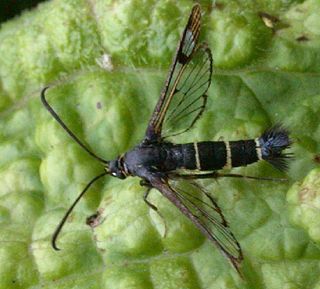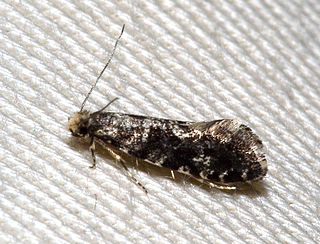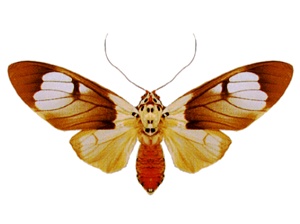Related Research Articles

The Sesiidae or clearwing moths are a diurnal moth family in the order Lepidoptera known for their Batesian mimicry in both appearance and behaviour of various Hymenoptera.

Tineidae is a family of moths in the order Lepidoptera described by Pierre André Latreille in 1810. Collectively, they are known as fungus moths or tineid moths. The family contains considerably more than 3,000 species in more than 300 genera. Most of the tineid moths are small or medium-sized, with wings held roofwise over the body when at rest. They are particularly common in the Palaearctic, but many occur elsewhere, and some are found very widely as introduced species.

William Forsell Kirby was an English entomologist and folklorist.

The Archipini are a tribe of tortrix moths. Since many genera of these are not yet assigned to tribes, the genus list presented here is provisional.

Amerila is a genus of moths in the subfamily Arctiinae. A number of species in this genus have a special defence mechanism when they are in their adult stage. When disturbed, they exude a frothy yellow fluid from glands beside the eyes, while making a sizzling noise to ward off their attacker. Similar behaviour has been observed in fertilised females of the North-American moth Utetheisa ornatrix.

Recurvaria is a genus of moths in the family Gelechiidae.

Idalus is a genus of moths in the family Erebidae. The genus was erected by Francis Walker in 1855.
Leucanopsis is a genus of moths in the family Erebidae. The genus was described by Alfredo Rei do Régo Barros in 1956.

Lophocampa is a genus of moths in the family Erebidae. The genus was erected by Thaddeus William Harris in 1841. It contains around 75 species.
Paracles is a genus of moths in the subfamily Arctiinae. The genus was described by Francis Walker in 1855. The species range from Panama to Patagonia, with quite a few in the southern temperate region of South America.

Spilosoma is a genus of moths in the family Erebidae originally described by John Curtis in 1825. A very heterogeneous group, it is in need of review by the scientific community, as certain species probably need reclassification into their own genera.
The Obtectomera is a clade of macro-moths and butterflies, comprising over 100,000 species in at least 12 superfamilies.
Eurythmia is a genus of snout moths. It was described by Émile Louis Ragonot in 1887.
Eurythmia hospitella is a species of snout moth in the genus Eurhodope. It was described by Zeller in 1875. It has been recorded from Arizona, Florida, Alabama, South Carolina and Illinois.
Eurythmia yavapaella is a species of snout moth in the genus Eurhodope. It was described by Harrison Gray Dyar Jr. in 1906, and is known from the US states of Arizona and California.

Eurythmia angulella is a species of snout moth in the genus Eurhodope. It was described by Charles Russell Ely in 1910 and is known from North America.

Xyloryctidae is a family of moths contained within the superfamily Gelechioidea described by Edward Meyrick in 1890. Most genera are found in the Indo-Australian region. While many of these moths are tiny, some members of the family grow to a wingspan of up to 66 mm, making them giants among the micromoths.

Gracillariinae are a subfamily of moths which was described by Henry Tibbats Stainton in 1854.

Acraga is a genus of moths of the family Dalceridae.
References
- ↑ Savela, Markku. "Eurythmia Ragonot, 1887". Lepidoptera and Some Other Life Forms. Retrieved September 14, 2017.
- ↑ 800274 – 6033 – Eurythmia furnella – Ely, 1910 at the Moth Photographers Group of Mississippi State University
| This Phycitinae-related article is a stub. You can help Wikipedia by expanding it. |